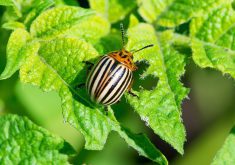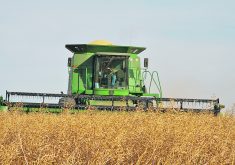A variety of roadblocks can impede commercialization of biological crop protection products, making them too expensive
Bio-pesticides aren’t ready to compete with synthetic pesticides in broad scale agriculture, said a retired Agriculture Canada scientist.
Research into bio-pesticides has waned in the last decade, partly because it takes so long to get products to market in Canada.
“I don’t see an appetite for these products in North America yet. In fact, I think we have regressed,” said Karen Bailey, a former researcher with Ag Canada in Saskatoon. “Ten years ago, there was more interest in bio-pesticides. But without immediate successes the interest has dwindled…. The availability and low pricing of herbicides is too competitive, especially in agriculture.”
Read Also

Why feds imposed EV tariffs
Moe and Kinew have a fight on their hands when it comes to eliminating the EV tariff. Canada has to worry about pissing off the U.S. and Mexico and hundreds of thousands of auto workers.
Bailey spent a fair chunk of her career on one bio-pesticide, Phoma macrostoma, a fungus that controls dandelions, Canada thistle, clover and other broad-leaf weeds, but doesn’t harm grasses or cereal crops.
She discovered the fungus in the 1990s and spent about a decade on the required studies and tests to get Phoma macrostoma registered with Health Canada’s Pest Management Regulatory Agency.
However, the bio-pesticide isn’t on the market in Canada.
It controls weeds in turf grass or cropland, but companies couldn’t find a way to cheaply manufacture the bio-herbicide.
“This process was more costly than any of the… industry partners would accept, as it did not meet their criteria for a satisfactory return on investment,” she said in an email. “There could have been a product for turfgrass but it would have been an expensive weed control relative to other commercially available ones…. This, in turn, meant the cost was too high for getting it used in agriculture.”
Biological pesticides are products derived from fungi, bacteria, minerals and other natural sources. They aren’t as effective as chemical pesticides, but can be used as part of an Integrated Pest Management strategy.
Bailey may be discouraged about bio-pesticides and their use in large scale agriculture, but Agriculture Canada sees it differently.
A decent number of bio-pesticides and alternative products are registered every year in Canada.
“In 2020-21, of the 10 new active ingredients approved, six were bio-pesticides. In 2019-2020, seven of the 12 new active ingredients were bio-pesticides, and in 2018-2019, of the 12 new active ingredients, eight were bio-pesticides,” an Ag Canada representative said in an email.
“Overall, approximately 1,000 products in this category are registered for use in Canada.”
In addition, federal agriculture minister Marie-Claude Bibeau is encouraging the use of crop protection products that aren’t synthetic pesticides.
Her mandate letter from the prime minister stated that she should “support food producers who choose alternative pest management approaches that reduce the need for chemical pesticides”.
To satisfy that mandate, Agriculture Canada invested $7 million in research and adoption of alternative pest management.
“Half of the 25 projects funded under this investment either are developing or evaluating bio-pesticides for key important pests,” Agriculture Canada said.
Ag Canada added there are challenges with getting bio-pesticides to market:
- Shelf life: can the product be stored at room temperature, or does it require refrigeration?
- Cost of production: “some products that work well in research trials cannot be produced at a cost that gives a commercial product enough margin to break even,” Ag Canada said.
- Bio-pesticides may only work on a certain pest in a specific crop. That’s great for the environment, but limits market opportunities.
- Can the product be used with equipment that is typically available on a farm?
“Bio-pesticides that satisfy these factors, making them favourable for marketing, are more likely to be licensed to a commercial partner and to ultimately reach the grower,” Agriculture Canada said.
Industry data shows that bio-pesticides are used primarily on horticultural crops.
The Biological Products Industry Alliance says 76 percent of all bio-pesticides were applied to fruit and vegetable crops in 2018. Row crops and cereals represent only 10 percent of the global market for bio-pesticides.
Canadian scientists have carried out extensive work on developing bio-pesticides for broad acreage crops, but few products have made it to market.
Bailey was able to find a commercial partner for her bio-herbicide, Phoma macrostoma, and she worked with PMRA scientists to collect the necessary safety information.
That took years and required deep pockets.
“Most small companies have neither the time nor financial resources to endure this process,” she said. “Most granting agencies do not have the long-term support for these projects, nor do they support funding for regulatory processes for projects which they have no ownership.”
It’s uncertain what will happen to Phoma macrostoma in Canada. However, it may get to market in the European Union. There’s more interest in bio-pesticides in the EU, where policy makers are pushing organic farming and discouraging the use of pesticides.
“Phoma has been licensed to a small European company (that) is hoping to resolve some of the issues and get it commercialized,” Bailey said.
















